It can be incredibly frustrating to wake up in the middle of the night sweating or shivering because you have the wrong covering on your bed. The type of covering you have affects how warm you will be while you sleep, and you’ll want to choose the right option for your preference and habits. However, the differences between bed coverings aren’t always clear – especially for products like quilts and blankets.
While quilts and blankets are both designed to provide warmth while you sleep, they have some key differences. Quilts usually consist of three layers of fabric, including a padded middle, that are decoratively stitched together. Blankets, by comparison, have just one layer of fabric.
This article will continue the comparison of quilt vs. blanket, highlighting the many differences you should be aware of. Also, we will discuss the construction, appearance, cost, and material makeup of these covers.
Quick Navigation
- What is a Quilt?
- What is a Blanket?
- Quilt vs Blanket: Comparison Chart
- What’s the Difference Between a Quilt and a Blanket?
- Can a Quilt be Used as a Blanket?
- Standard Quilt and Blanket Sizes
- Is a Quilt Thicker Than a Blanket?
- Are Quilts Warmer Than Blankets?
- Do You Have to Dry Clean a Quilt?
- Quilt vs. Comforter
- Quilt vs. Duvet
- Quilt vs. Coverlet
- Conclusion
What is a Quilt?
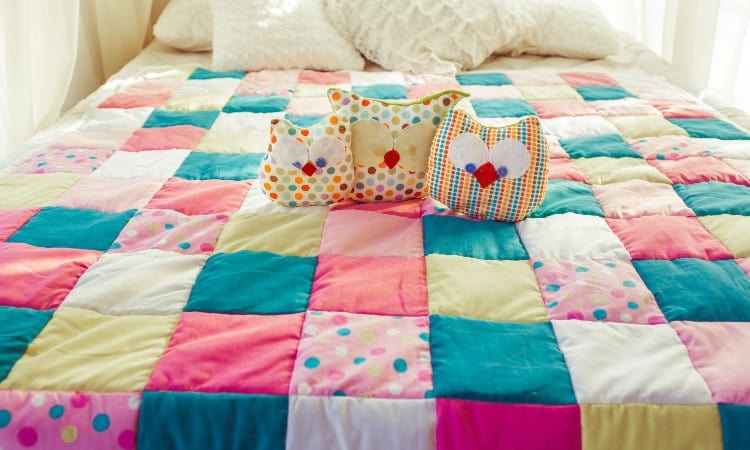
A quilt is a type of bed covering that is designed to keep you warm as you sleep. This warmth comes from three layers of fabric stacked together to make a single covering. The top and bottom layers are usually made from quilter-grade cotton fabric, while the middle layer is made of padded batting to keep you warm.
The top layer of a quilt is usually elaborate in design, with different colors and styles of fabric sewn together to make a striking pattern. Some quilt tops are designed to look symmetrical or geometric. Others may be designed to imitate the natural world, including plants, animals, or even nature scenes. There’s no limit to the designs that can be made on a quilt.
Once the layers of a quilt have been stacked together, they are attached to one another through a technique known as quilting. “Quilting” involves stitching across the surface of the covering in decorative ways, which fuses the layers into one piece. The stitches may be done in a crisscross pattern or in various elaborate swirls or abstract designs.
What is a Blanket?
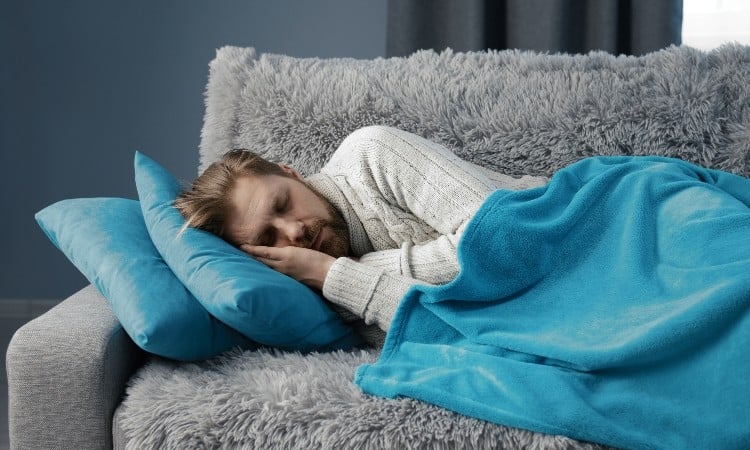
Blankets are also used for warmth while sleeping, though they are much simpler than quilts. They are made of just one layer of fabric, usually woven. They can come in a wide variety of colors and styles but will be the same on both sides – unlike quilts which usually differ from top to bottom.
The term “blanket” is often incorrectly used to describe any type of bed covering, even though the covering may not truly fit the definition of a blanket. Quilts, comforters, duvets, and coverlets are all commonly mislabeled as blankets, even though each is its own unique bed covering. It’s important to remember that a true blanket will only ever have one layer of fabric and will be used for warmth while sleeping.
Quilt vs Blanket: Comparison Chart
| Quilt | Blanket | |
|---|---|---|
| Construction | Three layers of fabric - the decorative top, middle padded batting, solid bottom layer | One layer of fabric, typically woven |
| Materials | Top and bottom typically made of quilter’s cotton; flannel, wool, and linen are also common | Wide variety of materials, including cotton, fleece, polyester, wool, acrylic, vellux, cashmere, or fiber blends |
| Weight | Heavier and often thicker | Generally lighter and thinner |
| Appearance | Often elaborate; top layer and bottom layer differ in appearance | Typically simpler; uniform in appearance from back to front |
| Cost | Expensive to make; requires purchasing and sewing of 3x as much fabric | Usually less expensive to produce; only requires creating one layer of fabric |
| Use | Warmth while sleeping; bedroom decoration; wall decor | Warmth while sleeping |
What’s the Difference Between a Quilt and a Blanket?
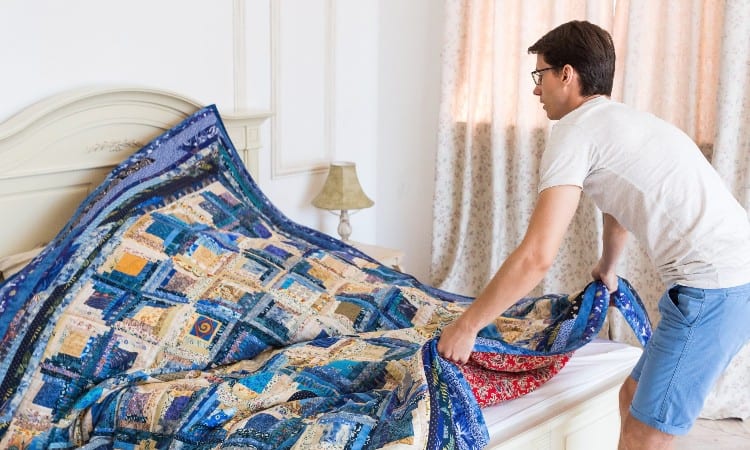
Construction
One of the main differences between quilts and blankets is how they are constructed. Quilts are made of three layers of fabric, each distinct from one another. Blankets, on the other hand, are made of just a single layer of fabric.
The top and bottom layers of a quilt usually differ in appearance from one another. Quilters usually spend a lot of time sewing together different colors and patterns of fabric to make elaborate designs on the top layer of the quilt. The bottom layer is generally a solid fabric, usually in a complementary color to the top layer.
The middle layer of a quilt is called batting or wadding, a padded layer that gives the quilt its warmth. Batting is layered between the top and bottom fabrics of the quilt, and the entire piece is then stitched together to become one. The topstitching of a quilt is also often done in elaborate designs since the stitching will be visible across the surface of the quilt.
Blankets, by comparison, are relatively simple constructions. They are made from a single layer of fabric that is woven. Since blankets have only one layer of fabric, they are generally the same in appearance throughout. There is no need for elaborate top stitching on a blanket to keep the fabric intact.
Materials
The outer layers of a quilt are typically made from quilter’s grade cotton fabric. This type of fabric is medium in weight and holds its shape well even after being washed. It is more robust than cotton fabrics used for apparel since it needs to be able to withstand being cut and pieced together into elaborate designs on the quilt top.
The outer layers of a quilt can be made of other fabric types, though these are less common. Flannel, wool, or linen can be used for these layers. Some quilters will even use old t-shirts as fabric for quilt tops.
The inner layer of the quilt is a thick layer of batting. Batting for quilts is usually made of polyester, cotton, or a blend of the two fibers. However, wool, bamboo, and silk alternatives are also available.
Blankets, by comparison, are usually made of uniform fibers throughout since they don’t contain multiple layers like quilts. Fleece, polyester, cotton, wool, acrylic, vellux, cashmere, or blends of these fibers are all commonly found in blankets. No matter the fiber type, blankets are generally woven and uniform in color and pattern from back to front.
Weight
Regarding weight, the general rule is that quilts are heavier than blankets. This is mostly because they have three layers instead of just one. Add in the top stitching and the binding around the outer edges, and there is much more weight than the single layer of fabric a blanket has.
However, this rule may not always hold true since there is some variation from quilt to quilt or blanket to blanket. Some blankets are increasingly being made with thicker or ‘chunky’ yarns to give them added bulk, which increases their weight.
Meanwhile, some quilts are made with lightweight cotton and minimal padding. This is generally done to make quilts that work well in the summer months without causing you to be overheated. These will be much lighter in weight overall.
But in general, quilts will be heavier in weight than blankets.
Appearance
Appearance is where quilts shine and is one of the reasons why they are so popular. The top layer of a quilt is usually very elaborate and draws most of the attention. Quilters will spend a lot of time creating unique fabric arrangements to make their quilt tops stand out.
The bottom layer of a quilt is usually different from the top layer and is often a solid fabric in a complementary color. The entire quilt is then topstitched in equally elaborate patterns. These patterns can be random, often referred to as ‘meandering,’ or can be precise repetitions of a deliberate design.
It is very common to see topstitching take the form of swirls, flowers, or paisley designs. Straight-lined designs like zigzags, chevrons, or grids are also popular. Some creative quilters even write words with their topstitching, giving the quilts extra meaning and detail.
Beyond the topstitching, quilts will also be bound along the outer edges with a fabric seam. This seam is what covers the raw edges of the fabric and keeps the entire piece together. The binding is usually made of a similar fabric to the top and bottom layers and won’t include added frills like fringe or tassels.
Blankets, by comparison, are typically woven and are the same on the front and back sides. The weave can have multiple colors and can be made into patterns. The woven patterns will often be simple, like stripes, chevrons, or plaid designs.
You will sometimes see blankets with added edge details like fringe or tassels. These are usually made of the same fibers as the rest of the blanket.
Cost
On average, quilts cost more than blankets to produce. This comes down to the layers involved in their creation and the considerable time it takes to topstitch a quilt.
A handmade queen-size quilt, for example, will require around 15 yards of fabric for the front, 8 yards for the back, and a queen-sized cut of batting. If the fabric is at a minimum price of $10 a yard and batting around $30, you’re looking at least a cost of $260 for just these supplies. This doesn’t include a pattern, needles and thread, outer binding, or the costs for hours of labor.
Blankets are much cheaper to produce, and require only one layer of fabric, usually made of common fibers like cotton or polyester. They generally take much less time and labor to produce, reducing costs.
There can be exceptions to this rule; though they are rare, Blankets made from custom or rare fibers, such as exotic wools or animal hairs, can be costly to produce. Hand-woven blankets will also be more expensive due to the labor involved in their creation.
Use
Both blankets and quilts are designed to keep you warm while you sleep. However, the appearance of quilts often means that they are used as decoration in many homes. Some people even use them as wall decor, making them a statement piece for everyone to see.
Because of the considerable time it takes to make them, quilts are also often treasured as family heirlooms or sentimental gifts. It’s not uncommon for quilts to be passed down through the generations of a family, which doesn’t often happen with blankets.
Can a Quilt be Used as a Blanket?
While they aren’t the same, quilts and blankets have common uses. A quilt can be used like a blanket to keep you warm while you sleep. They can be used as a bed covering, much in the same way that blankets can.
Standard Quilt and Blanket Sizes
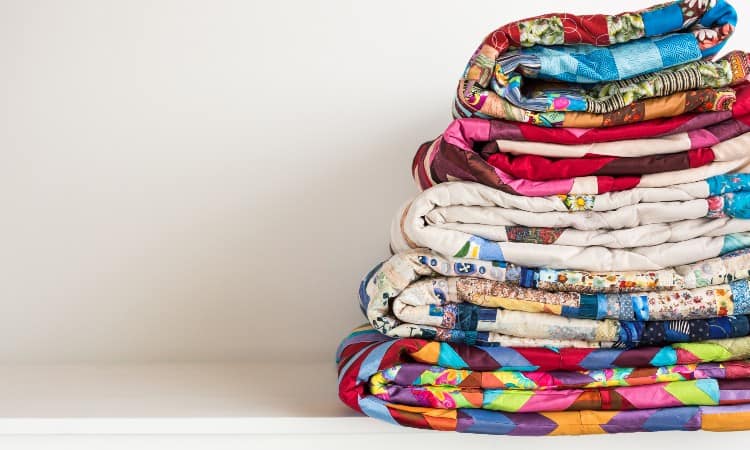
Quilts and blankets are often sold in standard dimensions, which correspond to standard mattress sizes. Each standard size has its own name and terminology, which are used fairly consistently across different brands and manufacturers.
A crib blanket or quilt is designed for use in an infant nursery. These coverings are usually around 27” by 52” in size and will fit in most standard cribs.
A throw blanket or quilt is designed for casual use around the home and is often draped on the back of a chair or couch. These coverings are typically 50” by 60” in size and will comfortably cover a single person.
A twin blanket or quilt fits the smallest standard mattress for older children or adults. These coverings are usually around 66” by 90” in size.
A twin-XL blanket or quilt is a slightly longer version of a twin-sized covering and is most often seen in college dormitories. These coverings are usually around 66” by 95” in size.
A full or double blanket or quilt is the next size above a twin. These coverings are typically 80” by 90” in size.
A queen blanket or quilt is one of the largest commonly available sizes. These coverings are typically 90” by 100” in size.
A king blanket or quilt is the largest standard size available in most retail stores. These coverings are typically 108” by 100” in size. California king blankets are also available through specialty shops, and these are typically narrower and longer than standard kings at 104” by 108”.
Is a Quilt Thicker Than a Blanket?
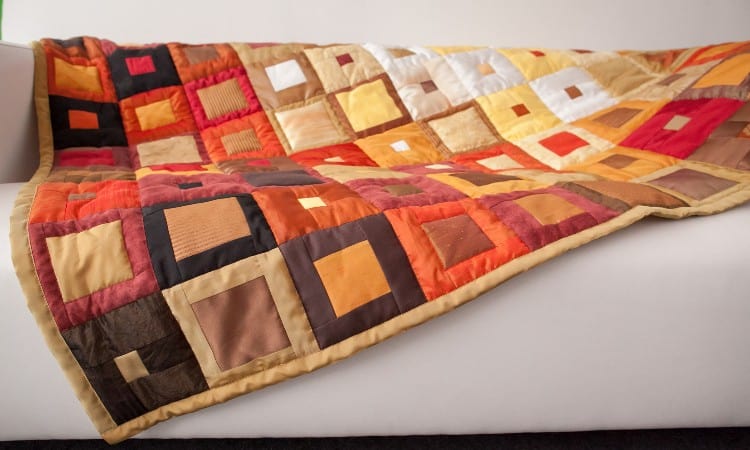
Generally, yes. Quilts have three layers of fabric, including a layer of batting that gives them extra padding. This padding is thick to keep you warm while you sleep.
Blankets are generally much thinner because they are only made of a single layer of fabric. Rare exceptions to this rule happen, usually when blankets are woven with thick yarns made of custom fibers. A single layer of extra thick yarn could technically be thicker than a quilt.
However, this is not usually the case. Extra thick blankets will generally be labeled as such to give you a clue that they are thicker than normal.
Are Quilts Warmer Than Blankets?
Quilts are usually warmer than blankets. This warmth comes from the multiple layers used in their construction – especially the padded batting in the middle. But there can be a tremendous amount of variation from quilt to quilt.
A cotton quilt filled with cotton batting will be very lightweight and most appropriate for summer weather. A thick wool blanket may be warmer than this type of quilt. It depends on what each is made of and how thick it is.
Wool is almost always warmer than cotton. Fleece and down are also very warm options and warmer than cotton. You’ll want to keep this in mind and pay attention to the fibers in each when choosing between a blanket or a quilt.
Do You Have to Dry Clean a Quilt?
No, you do not have to dry clean a quilt. The chemicals in dry cleaning could even damage a quilt – especially an heirloom one.
Instead, wash your quilt in your home washing machine on the gentle cycle. Use cold water and a gentle detergent. Try not to wash your quilts with anything that could bleed dyes or could snag and tear the fabric.
Always air dry your quilts or dry them on the lowest heat setting possible. If you use a machine to dry your quilts, only leave them in until they are damp and let them air dry the rest of the way. Too much heat can ruin the look of the top layer of the quilt and cause it to shrink in odd ways.
If you are cleaning heirloom or hand-sewn quilts, your best bet is to hand wash. These covers can be too delicate for even the gentlest cycles on your washing machine. You should always air dry these quilts as well.
Quilt vs. Comforter
“Comforter” is a term used to describe thick bed coverings meant for extra warmth while you sleep. Comforters are often much warmer than quilts because they are much thicker. Quilts tend to be thin and flat in comparison to comforters.
Comforters are usually filled with down, cotton, or polyester stuffing. They are not fully topstitched like a quilt is, however. Instead, the comforter is only stitched around the outer edge, with the occasional line going across the cover to help keep the loose stuffing in place.
Comforters can have patterns or designs on their outer layers, but the designs are not made from stitched-together fabrics like quilt tops are. The front and back of a comforter are often the same, though that is not a requirement. These outer fabrics are generally woven.
Quilt vs. Duvet
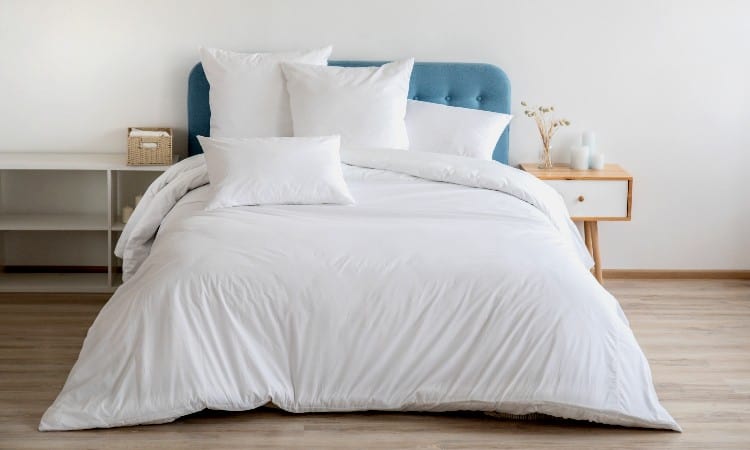
A duvet is a type of comforter – specifically one that is white and usually filled with down. You have probably seen a duvet if you have ever stayed in a hotel since they are a common choice for these establishments.
Duvets are often encased in a duvet cover to protect the white fabric from dirt and stains. The covers can be easily removed and washed, which is simpler than washing the entire duvet. The covers come in various styles and fabrics and can be coordinated to match any decor.
Quilts, of course, are not as thick or fluffy as comforters or duvets. They are not typically filled with down and don’t tend to come with covers to protect them.
Quilt vs. Coverlet
A coverlet is a lightweight, thin layer often placed on top of your bedding. This layer is often more decorative than warm, meaning a coverlet alone is probably insufficient to sleep with. These covers are typically not as large as standard quilt sizes since they aren’t meant to extend past the mattress.
Coverlets tend to be made of cotton or cotton blends. They don’t have any filling or batting as quilts or comforters do. They can have patterns or designs, but these will be woven into or printed on the fabric rather than pieced together like a quilt top.
Conclusion
The term “blanket” is often used universally to describe any bed coverings, but this article helped to show the many differences between quilts and blankets. You now have all the information you need to decide which type of bed covering will work best for you in your home. As you make your choice, keep this guide handy to give you all the information you’ll need!